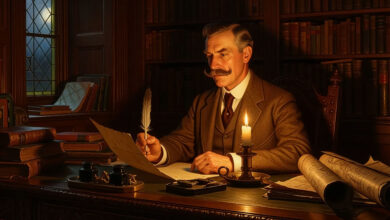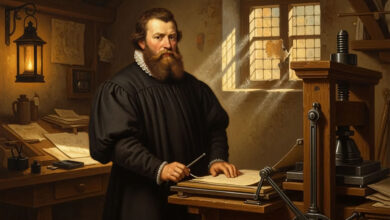James Augustine Aloysius Joyce was born on 2 February 1882 in Rathgar, a suburb of Dublin, Ireland. He became one of the most influential writers of the twentieth century, renowned for his modernist approach to literature and his groundbreaking use of stream-of-consciousness narration. His works, including “Ulysses,” “A Portrait of the Artist as a Young Man,” and “Finnegans Wake,” redefined the novel as an art form and left an indelible mark on literary history.
Joyce was born into a large Catholic family, but financial instability plagued his early years. His father, John Stanislaus Joyce, had once been financially comfortable but gradually squandered his wealth, leaving the family in increasingly dire circumstances. Despite these hardships, Joyce excelled in his studies. He attended Clongowes Wood College, a Jesuit school, before moving on to Belvedere College and later University College Dublin. It was during his university years that he developed his love for literature, particularly the works of Henrik Ibsen, which influenced his own writing style.
In 1902, Joyce left Ireland for Paris to study medicine, but he quickly abandoned this pursuit to focus on writing. His time in Paris was marked by poverty and struggle, and he was forced to return to Dublin following his mother’s illness and subsequent death in 1903. This period deeply affected him and would later find its way into his writing, particularly in “A Portrait of the Artist as a Young Man.”
In 1904, Joyce met Nora Barnacle, a young woman from Galway who would become his lifelong companion and muse. That same year, they left Ireland together, beginning a peripatetic existence that took them to cities across Europe, including Trieste, Zurich, and Paris. He worked as a teacher while simultaneously dedicating himself to writing, producing early versions of what would become some of his most famous works.
Joyce’s first major publication, “Dubliners,” was a collection of short stories that painted a vivid and often unflattering picture of life in Dublin. Published in 1914 after a protracted struggle with publishers who objected to its realism, the collection remains one of the most celebrated works in Irish literature. “A Portrait of the Artist as a Young Man,” published in 1916, was a semi-autobiographical novel that traced the intellectual and emotional development of Stephen Dedalus, a character often seen as a stand-in for Joyce himself.
His most celebrated work, “Ulysses,” was published in 1922, revolutionising modern literature with its intricate structure and deep exploration of the human mind. The novel follows a single day in the life of Leopold Bloom as he moves through Dublin on 16 June 1904, a date now commemorated annually as Bloomsday. Employing stream-of-consciousness narration, experimental prose, and an encyclopedic range of literary styles, “Ulysses” was both lauded and condemned upon its release. It was banned in the United States and the United Kingdom for alleged obscenity, leading to a protracted legal battle before it was finally published in full in 1934.
Despite the controversy surrounding “Ulysses,” Joyce continued to push literary boundaries with “Finnegans Wake,” published in 1939. This novel, written in an intricate and almost impenetrable language, explored themes of history, mythology, and human consciousness in a dream-like structure. Though some critics dismissed it as unreadable, others hailed it as a masterpiece of linguistic innovation.
Joyce’s later years were marked by increasing health issues, particularly concerning his eyesight. He underwent multiple surgeries for glaucoma and cataracts, yet he continued to write and correspond with fellow authors and intellectuals. During the Second World War, Joyce and his family were forced to leave Paris, eventually finding refuge in Zurich, Switzerland.
On 13 January 1941, Joyce died in Zurich following complications from a perforated ulcer. He was 58 years old. His death marked the end of a literary career that had fundamentally reshaped the novel and influenced generations of writers. He was buried in Fluntern Cemetery, where his grave remains a site of pilgrimage for literature enthusiasts worldwide.
Joyce’s legacy is one of unparalleled literary innovation. His ability to capture the complexities of human thought and experience, coupled with his fearless experimentation with language, ensured his place among the greatest writers of all time. “Ulysses” continues to be studied and celebrated, while his influence can be seen in the works of writers as diverse as Samuel Beckett, William Faulkner, and Jorge Luis Borges. His depiction of Dublin remains one of the most evocative portrayals of any city in literature, despite his self-imposed exile from Ireland for most of his life.
Though Joyce was often at odds with his homeland, his work remains deeply rooted in Irish culture and history. His exploration of identity, religion, and national consciousness reflected both his personal struggles and the broader tensions within Irish society. His reputation has only grown over the years, with numerous statues, museums, and literary festivals dedicated to his memory. Bloomsday, celebrated every 16 June, continues to draw readers and scholars to Dublin, retracing the steps of Leopold Bloom and honouring Joyce’s monumental contribution to literature.
Joyce’s impact on modernist literature cannot be overstated. His innovative use of stream-of-consciousness, interior monologue, and non-linear narrative structures reshaped the form of the novel. He challenged readers to engage with literature in new ways, demanding attentiveness, interpretation, and an appreciation for linguistic experimentation. While some of his works remain daunting for casual readers, they continue to inspire scholars and writers to explore the boundaries of fiction. More than a century after the publication of his earliest works, Joyce’s influence endures. His novels, essays, and letters offer a profound insight into the mind of a writer who sought to capture the full spectrum of human experience. Whether through the intimate struggles of Stephen Dedalus, the everyday musings of Leopold Bloom, or the dreamlike wanderings of “Finnegans Wake,” Joyce’s voice continues to resonate. His dedication to his craft, his relentless pursuit of artistic innovation, and his fearless challenge to literary conventions ensure that his place in the pantheon of great writers remains secure. Joyce’s Dublin, his language, and his vision remain as compelling today as they were in his lifetime, a testament to the power of literature to transcend time and place.




